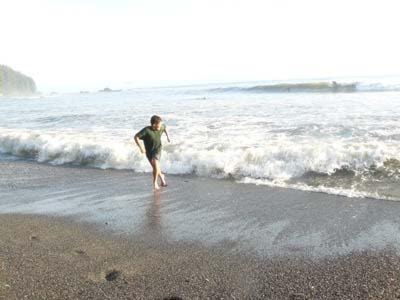Debris washing up on Vancouver Island’s west coast isn’t coming from the Japanese tsunami, says a B.C. oceanographer.
Richard Thomson, a researcher in coastal and deep-sea physical oceanography within the Ocean Sciences Division of the Department of Fisheries and Oceans, said it’s highly unlikely any of the debris being found on Vancouver Island beaches resulted from the tsunami.
“Nobody knows for sure, but our best estimate is that somewhere in the spring or summer of 2013 we should start to see some things,” he said. “It’s almost impossible for anything to have made it by now.”
There are a number of reasons for that, he said.
“If it’s mainly carried by the currents then it’s very slow, maybe 10 kilometres per day,” he said. “The currents meander and there are a lot of eddies in them that could carry the debris in the opposite direction, back towards Japan. The currents wander all around, but the general drift of the North Pacific current takes things towards our coast, but it’s over 7,600 kilometres on a direct circle route from Japan, so a few kilometres of drift a day will take a long time.”
Thomson, who studies ocean currents as part of his job with the DFO, said it’s unclear how much of the debris will wash up in B.C. even when it does get here.
“When the current gets here, it doesn’t run right onshore. When it gets 800 kilometres offshore the current starts to split, with one flow going up into the Gulf of Alaska and becoming the Alaska current, while the other one, the California current, goes south. So some of the debris will go into the Gulf of Alaska and some will go parallel to the California coast.”
Much of the debris, he said, could find itself stuck in the North Pacific garbage patch or even make its way back onto Japanese shores.
“Most of the debris is going to stay out in the ocean,” he said. “Early predictions are that 95 per cent of it will stay offshore.”
Lighter items, he said, may eventually make their way to be B.C. coast, as they are more likely to be impacted by prevailing winds and wave action.
“Wood is pretty light and will float near the surface, where there is wind and wave action,” he said. “Foam will make it, but not houses. The waves out in the North Pacific will beat the tar out of them. If you had a sealed freezer with air in it, it would probably stay out there and not really come ashore.”
Thomson conceded that much of his theory is based on informed guesswork, as Canada has never faced a situation like this before.
“We’re guessing, because we don’t have a lot to go by,” he said. “This is the first major event of its kind.”
However, he dismissed claims that some of the water bottles and other debris being touted as tsunami trash was in the water long enough to cross the entire Pacific Ocean.
“It’s at least a year too early,” he said. “Some of the bottles had labels on them. The glue in those labels wouldn’t last that long.”
Other debris, he stressed, would be covered in barnacles and other sea life if it had been floating in the open ocean for an extended period of time — while none of the debris found so far seems to carry much in the way of sea life.
news@pqbnews.com
